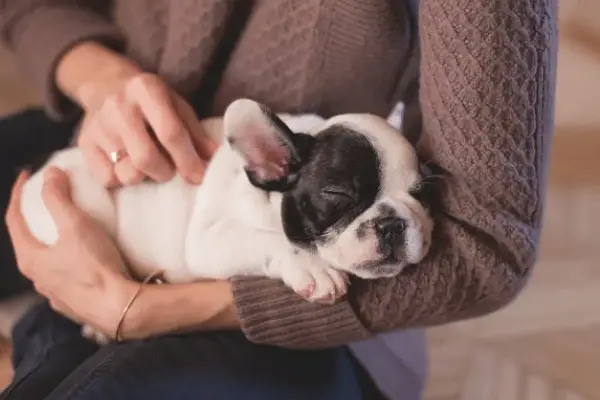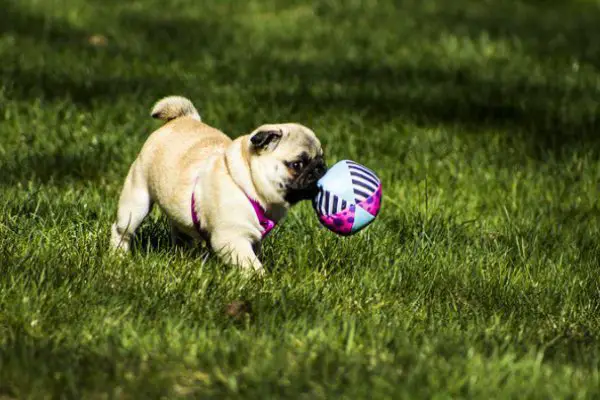How to Trim Dog Nails [A Step-by-Step Guide]
![How to Trim Dog Nails [A Step-by-Step Guide] How to Trim Dog Nails](https://petcreeks.com/wp-content/uploads/2023/09/Copy-of-Copy-of-Copy-of-Copy-of-Copy-of-Copy-of-Untitled-Design_20230924_164757_0000.jpg)
Hey there fellow dog parents! Have you ever struggled with trimming your furry friend’s nails? Don’t worry, I’ve got your back.
In this blog post, I’ll share my top tips and tricks on how to trim dog nails like a pro, so you can keep those paws happy and healthy.
Let’s get started!
Benefits of Trimming Your Dog Nails
Trimming your dog’s nails offers several benefits for both your dog’s health and your own convenience. Here are some common benefits of trimming your dog’s nails:
Preventing Overgrowth: Regular nail trimming prevents your dog’s nails from becoming too long and curling back into the paw pad. Overgrown nails can be painful and cause difficulty walking or running.
Maintaining Proper Posture: Long nails can affect your dog’s posture and balance. Trimming their nails helps them maintain proper alignment and prevents joint and muscle strain.
Preventing Injuries: Overgrown nails are more prone to breakage and can splinter or tear, causing pain and potential infections. Trimming your dog’s nails minimizes the risk of these injuries.
Preventing Damage to Floors and Furniture: Long nails can scratch and damage your floors, furniture, and carpets. Regular trimming prevents these unwanted damages.
Improving Traction: Properly trimmed nails provide better traction and grip, especially on smooth surfaces. This is especially important for older dogs or those with mobility issues.
Reducing Pain and Discomfort: Long nails can put pressure on the toe joints, leading to pain and discomfort. Trimming your dog’s nails alleviates this discomfort and improves their overall well-being.
Preventing Nail Infections: Overgrown nails can trap dirt, debris, and moisture, creating an environment for bacterial or fungal infections. Regular nail trimming reduces the risk of these infections.
Promoting Healthy Foot Structure: When nails are too long, they can push the toes apart, causing the foot to splay. Trimming your dog’s nails helps maintain the natural shape and structure of their feet.
Easier Veterinary Examinations: Shorter nails make it easier for veterinarians to examine your dog’s paws and perform necessary procedures, such as blood tests or administering medications.
How to Trim Dog Nails
![How to Trim Dog Nails [A Step-by-Step Guide] Trimming Dog nails](https://petcreeks.com/wp-content/uploads/2023/09/Copy-of-Copy-of-Copy-of-Copy-of-Copy-of-Copy-of-Untitled-Design_20230924_164850_0000.jpg)
To trim a dog’s nails, start by getting them comfortable with the process by handling their paws gently. Use a specialized dog nail trimmer to carefully trim just the tip of the nail, avoiding the quick.
Take breaks if needed, and reward your dog with treats and praise to make the experience positive.
Let’s break it down further…
The following are some steps on how to trim dog nails:
Step 1: Gather Your Dog Nail Trimming Supplies
Before you embark on the dog nail-trimming journey, it’s essential to gather your supplies thoughtfully. Firstly, you’ll need to decide between two primary tools: nail clippers or a grinder.
Nail clippers come in various styles, such as guillotine or scissor-type. The choice usually boils down to your comfort and your dog’s preference.
Grinders, on the other hand, use an abrasive surface to file down the nail. You may also need styptic powder, a lifesaver if you accidentally cut into the quick, and some delicious treats to reward your furry friend.
Step 2: Get Your Dog Comfortable
Creating a comfortable and relaxed environment is key to a successful nail trimming session.
Find a quiet, well-lit area where both you and your dog can unwind. It’s essential that your dog feels at ease with you handling their paws.
Spend some quality time together, offering gentle belly rubs or playtime to ease any anxiety. This step sets the foundation for a positive experience.
Step 3: Examine the Nails
Now, let’s delve into understanding your dog’s nails. Each nail consists of a hard, outer shell and a pinkish inner part known as the quick.
The quick is sensitive, housing blood vessels and nerves. Your main goal is to avoid cutting into the quick, as it can be painful and cause bleeding.
Take your time to inspect your dog’s nails closely, so you can distinguish where the quick ends and the hard outer shell begins.
Step 4: Choose Your Method
The choice between nail clippers and grinders depends on your comfort level and your dog’s temperament.
Clippers operate much like scissors, snipping off the nail tip. Grinders, on the other hand, use a rotating abrasive surface to gradually file down the nail.
Some dogs might be more accepting of one method over the other. Experiment to see which your dog tolerates better, and what you feel more confident using.
Step 5: Begin the Trimming
Now, the actual trimming begins. Gently, yet firmly, hold your dog’s paw. If you’re using clippers, make precise, controlled cuts, ensuring you steer clear of the quick.
Be patient and take your time. If you’re opting for a grinder, lightly touch the grinder to the nail’s tip and slowly remove excess length.
Keep in mind that grinding can generate heat, so brief touches and pauses are essential to prevent discomfort.
Step 6: Reward and Praise
Positive reinforcement is your best friend throughout this process. After each successful trim, reward your dog with a tasty treat and plenty of verbal praise.
Let them know they’re doing wonderfully. This positive association will help your dog feel more comfortable during future nail trimming sessions.
Step 7: Check for Bleeding
Despite your best efforts, accidents can happen, resulting in bleeding if you cut too close to the quick.
Don’t panic; it’s manageable. Apply a small amount of styptic powder to the bleeding area.
This powder helps stop the bleeding by contracting blood vessels. Having it on hand is a wise precaution for these moments.
Step 8: Repeat for All Nails
This process is iterative, as dogs typically have multiple nails on each paw. Go through all the nails, taking breaks if necessary.
It’s essential not to rush, as haste can lead to mistakes and increased anxiety for your dog.
Step 9: Final Check
Once all the nails are trimmed, give them a careful inspection. Ensure they are all even and well-trimmed.
If you notice any sharp edges or unevenness, use a nail file to gently smooth them out.
This step guarantees your dog’s paws are comfortable and free from any discomfort.
Step 10: Clean Up
Lastly, dispose of any nail clippings or clean the grinder thoroughly. Treat your dog to another well-deserved treat and shower them with affection for being such a trooper throughout the process.
Step 11: Maintenance
Regular nail maintenance is essential. The frequency of nail trimming depends on your dog’s individual growth rate, but a general guideline is every 2-4 weeks.
By practicing regularly, you’ll become more skilled at identifying the quick and making precise cuts.
Common Challenges in Trimming a Dog Nail
When it comes to trimming a dog’s nails, there are several common challenges that pet owners may face.
These challenges can make the process difficult and stressful for both the owner and the dog.
Here are some common challenges in trimming a dog’s nails and how to address them:
1. Fear or Anxiety: Many dogs are afraid or anxious about having their nails trimmed. This can be due to past negative experiences or simply a fear of the unknown. To address this challenge, it’s important to create a positive and calm environment. Start by getting your dog comfortable with having their paws touched and gently handling their feet. Gradually introduce the nail clippers or grinder, allowing your dog to sniff and investigate them. Use positive reinforcement techniques, such as treats and praise, to reward calm behavior throughout the process.
2. Resistance or Restlessness: Some dogs may resist or become restless during nail trimming. They may pull their paws away, wiggle, or try to escape. To address this challenge, ensure that you have a secure and comfortable area for nail trimming. Use a non-slip surface, such as a rubber mat, to prevent your dog from sliding or slipping. Have someone assist you by gently restraining your dog or distracting them with treats or toys. It may also help to break the nail trimming session into shorter, more manageable sessions to prevent your dog from becoming too stressed or overwhelmed.
3. Overgrown Nails: Overgrown nails can pose a challenge during trimming as they may be thicker and harder to cut. Additionally, long nails can be more prone to splitting or bleeding if cut too short. To address this challenge, it’s important to regularly trim your dog’s nails to avoid overgrowth. Start by gradually trimming small amounts of the nail at a time to prevent cutting into the quick, which is the sensitive part of the nail that contains blood vessels and nerves. If you’re unsure about how much to trim, consult with a professional groomer or veterinarian for guidance.
4. Dark or Black Nails: Dogs with dark or black nails can make it difficult to see the quick, making owners hesitant to trim the nails for fear of causing bleeding. To address this challenge, it’s helpful to have a good source of lighting and use a bright-colored nail trimmer or grinder. Carefully trim small amounts of the nail at a time, observing for any signs of the quick, such as a gray or pinkish coloration. If you’re uncertain, seek guidance from a professional groomer or veterinarian.
5. Lack of Experience or Knowledge: Many pet owners may lack experience or knowledge in proper nail trimming techniques, which can make the process more challenging. To address this challenge, it’s important to educate yourself on the proper techniques for nail trimming. There are various resources available, such as online tutorials, books, or even professional grooming classes. Consider seeking guidance from a professional groomer or veterinarian who can demonstrate the correct technique and provide hands-on guidance.
Precautions to Take When Trimming Your Dog’s Nails
When trimming your dog’s nails, it’s important to take certain precautions to ensure the safety and comfort of your furry friend. Here are some precautions to keep in mind:
1. Use the right tools: It’s crucial to use nail clippers or grinders specifically designed for dogs. Using improper tools can cause pain, injury, and discomfort to your dog. Choose clippers or grinders that are suitable for your dog’s size and nail thickness.
2. Be familiar with the anatomy: Before trimming your dog’s nails, educate yourself about the anatomy of the nails and the quick. The quick is a sensitive area that contains blood vessels and nerves. Trimming too close to the quick can cause bleeding and pain. Familiarize yourself with where the quick is located to avoid any mishaps.
3. Gradually introduce nail trimming: Many dogs are initially fearful or anxious about having their nails trimmed. It’s important to introduce nail trimming gradually and in a positive manner. Start by getting your dog comfortable with having their paws touched and gradually introduce the clippers or grinder. Use treats and positive reinforcement to associate the experience with something pleasant.
4. Trim a small amount at a time: When trimming your dog’s nails, it’s better to err on the side of caution and trim a small amount at a time. This helps reduce the risk of cutting into the quick. Regularly inspect the nails and trim just the tip, avoiding the quick. If in doubt, consult your veterinarian or a professional groomer for guidance.
5. Take breaks if needed: If your dog becomes stressed or uncomfortable during the nail trimming process, it’s important to take breaks. Pushing your dog beyond their comfort level can lead to negative associations and make future nail trims more challenging. Make sure to provide plenty of praise, treats, and reassurance throughout the process.
What to do if you accidentally cut the quick while trimming your dog’s nails
If you accidentally cut the quick while trimming your dog’s nails, the first step is to remain calm. Apply styptic powder or cornstarch to the bleeding nail to help stop the bleeding.
Avoid using human products like hydrogen peroxide or alcohol as they may irritate the wound. Keep an eye on the nail for any signs of infection, such as redness, swelling, or discharge.
If the bleeding doesn’t stop or the dog shows signs of pain or discomfort, consult a veterinarian for further guidance and care.
Frequently Asked Questions
What if my dog’s nails are black and I can’t see the quick?
If your dog has black nails, it can be more challenging to identify the quick. In these cases, it’s important to be extra cautious. Start by trimming a small portion of the nail at a time, making sure to avoid the pink area. If you’re uncertain, it’s better to trim less than risk cutting into the quick. Regular maintenance trims can help gradually shorten the nails and reduce the risk of cutting too deep. If you’re unsure or uncomfortable, consult a professional groomer or veterinarian for assistance.
What should I do if I accidentally cut into the quick?
Accidentally cutting into the quick can be painful for your dog and may cause bleeding. If this happens, remain calm and try not to panic. Apply gentle pressure to the nail with a clean cloth or styptic powder to help stop the bleeding. Styptic powder can be found at pet supply stores and helps promote clotting. If bleeding persists or your dog appears to be in significant pain, contact your veterinarian for further guidance and assistance.
Are there alternatives to trimming dog nails?
While regular nail trims are the most effective way to maintain optimal nail length, there are some alternatives that can help naturally wear down your dog’s nails. These include providing your dog with regular walks on pavement or concrete, as the friction can help file down the nails. Using scratching posts or providing appropriate chew toys can also contribute to nail maintenance. However, it’s important to note that these methods may not be sufficient for all dogs, especially those with fast-growing nails or certain breeds that are prone to nail issues. Regular nail trims are still recommended to ensure your dog’s comfort and overall paw health.
Why is it important to trim dog nails?
Trimming dog nails is important for several reasons. Firstly, long nails can be uncomfortable and painful for dogs, causing them to have difficulty walking or running. It can also lead to joint and posture problems. Secondly, overgrown nails are more prone to breakage and splitting, which can be painful and may even result in infection. Lastly, regular nail trims help prevent scratches and injuries to both humans and dogs during play or interaction.
How often should I trim my dog’s nails?
The frequency of nail trims depends on various factors, including the breed, activity level, and the dog’s lifestyle. In general, it is recommended to trim your dog’s nails every 4-6 weeks. However, some dogs may require more frequent trims if their nails grow quickly or if they are not naturally worn down through exercise on hard surfaces. It’s important to monitor your dog’s nails regularly and trim them when they start to get too long.
Conclusion
So there you have it, folks! Trimming your dog’s nails doesn’t have to be a daunting task.
With a little patience, practice, and the right tools, you can keep your fur baby’s paws happy and healthy. Remember, a little trim goes a long way!






